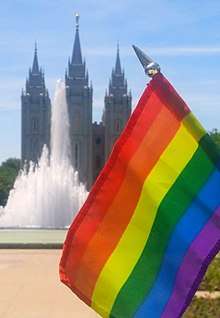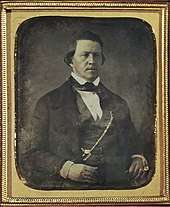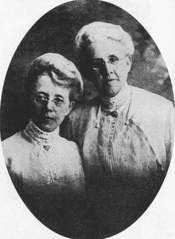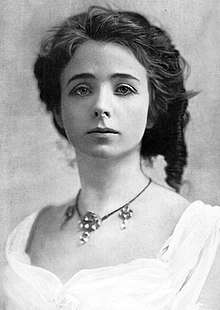Timeline of LGBT Mormon history in the 19th century
This is a timeline of LGBT Mormon history in the 19th century, part of a series of timelines consisting of events, publications, and speeches about LGBTQ+ individuals, topics around sexual orientation and gender minorities, and the community of members of The Church of Jesus Christ of Latter-day Saints (LDS Church). Although the historical record is often scarce, evidence points to queer individuals having existed in the Mormon community since its beginnings. However, top LDS leaders only started regularly addressing queer topics in public in the late 1950s.[1]:375,377[2]:v,3[3]:170 Since 1970, the LDS Church has had at least one official publication or speech from a high-ranking leader referencing LGBT topics every year, and a greater number of LGBT Mormon and former Mormon individuals have received media coverage.
| LGBT Mormon topics |
|---|
 |
|
General articles |
|
Current organizations |
|
Previous organizations |
|
|
Timeline
1800s
1805
- December – Joseph Smith, the founder of Mormonism, was born.[4]:9
1810s
1820s
1820
- Spring – Smith later reported that beginning at this time he received a vision of deities and later visitations from an angel.[4]:xiii
1830s
1830
- March – The Book of Mormon was first published.[4]:xiii
- April – The early church was officially organized as the Church of Christ.[4]:xiii
1840s
1842
- May – The first known instance of church discipline related to same-sex sexual activity was an excommunication for the alleged bisexual behavior of 37-year-old church leader John Bennett,[1]:266–267 who was accused of "buggery" by Joseph Smith's brother William in The Wasp newspaper.[5][6] Historian Samuel Taylor also alleged that Joseph Smith caught Bennett having sex with 21-year-old Francis Higbee[7]:168 though these interpretations of the accounts and the homosexual allegations against Bennett have been challenged.[7]:165–171
- July – The Wasp newspaper also reported that the apostle Orson Pratt implicitly accused Joseph Smith of engaging in same-sex sexual activity.[8]
1850s
1851

- 1851 – The church-controlled legislature of the newly formed Utah territory passed the first law addressing same-sex sexual behavior banning any "man or boy" from "sexual intercourse with any of the male creation" with penalties left to the courts' discretion.[9]:1200 Brigham Young acted as both Utah governor and church president in the theocratic government and oversaw the selection of the legislators.[10]
1853
- April – The apostle Parley Pratt taught that God destroyed Sodom due to its "lawless abominations" and for predisposing its children "to be fully given to strange and unnatural lusts, appetites, and passions".[11][1]:296,412 This contrasted with church founder Joseph Smith's teaching a decade earlier that it had been destroyed for rejecting the prophets (rather than citing the traditional sexual interpretation).[1]:296,409[12]
1856
- The first known reference to lesbians in Mormon history occurred in 1856, when a Salt Lake man noted in his diary that a Mormon woman was "trying to seduce a young girl."[13]
1855
- April – The church's newspaper printed an article in which mission president Nathanial Vary Jones of the East India Mission in Calcutta, India[14] falsely states that around the year 1700 the people of Burma (Myanmar) were about to become extinct because the men were practicing "the crime of Sodomy" instead of procreating with the women until the king and queen decreed that the women should wear clothing that exposed more skin in hopes of "reclaiming their men" which prevented their people's extinction.[15]
1858
- April – Travelling bishop and later church historian Milton Musser wrote that Salt Lake City member Almerin Grow had demonstrated odd behavior and was wearing his wife's clothing in one of the first reported instances of gender non-conforming dress in the Mormon community. Church president Young subsequently sent him south to "never return," so Grow appointed Musser as guardian of his daughter.[16][17]
1860s
1862
- April – Church president Brigham Young stated that "men will be sealed to men back to Adam" in reference to same-sex sealings in which men were sealed to other unrelated men in the Law of Adoption practiced in early Mormonism.[1]:414[18][19]
1870s
1876
- February – Seventeen-year-old, George Naylor was sent on a mission to Arizona to separate him from his 28-year-old non-Mormon lover Frank Wells by church leaders citing their "scandal and improper connexion [sic]".[9]:1200 There were no recorded excommunications for homosexual conduct under Brigham Young's time as church president (i.e. 1845–1877).[1]:274
1879
- November – Twenty-six-year-old Arthur Bruce Taylor (1853–1924?),[20] the son of then current church president John Taylor, had a long discussion with second counselor Joseph F. Smith who wrote in his journal that Bruce was "acane!". Smith had served a church mission in Hawaii where he became acquaintance with the Aikane custom where young males were socially acceptable sexual companions of older male leaders. Soon after this meeting Bruce left the LDS Church and moved to Oregon where he never married.[1]:40–41,232
1880s
1882
- September – After hearing of a group of teenage males engaging in same-sex sexual activity First Presidency member Joseph F. Smith told the Richfield, Utah stake presidency to "get the names of all of them & cut them off the church" and described their behavior as a monstrous, obscene, filthy iniquity for which Sodom and Gomorrah was burned. This was the first known excommunication of teenagers for same-sex sexual activity.[1]:276,299
1885

- 1885 – Brigham Morris Young, a founder of the church Young Men's program and a son of church president Young, began performing in drag as a Vaudeville female impersonator Madam Pattirini. He sang opera in falsetto throughout Utah into the early 1900s, and his gender-non-conforming act was well-received at church social events.[21][1]:232 While historical evidence does not point to Young being a sexual or gender minority, it has been speculated by historian Michael Quinn that Mormon Tabernacle Choir director Evan Stephens (who also performed in drag during the late 1800s)[22] was physically attracted to other males.[1]:235–237[23]
1886
- 1886 – The Salt Lake City Bohemian Club was founded,[1]:69–70 becoming a safe haven by 1905 for homosexual persons, including many current and former Mormons.[1]:69,71 By 1908 the club's discussions and associations became more overtly homosexual[1]:73 with lesbian club member Mildred Berryman (who was Mormon for a time)[1]:69,226–228 beginning her thesis The Psychological Phenomena of the Homosexual[1]:223 in 1928[1]:228 on 23 lesbian women and 9 gay men, many of whom she met through the club.[24]:20[1]:69,73 Berryman reported being acquainted with one hundred homosexual persons in Salt Lake.[1]:222 The Bohemian Club continued until 1942.[1]:73
1889

- 1889 – May Anderson moves in with Louie B. Felt, the first general president of the Primary organization. After the death of Felt's husband in 1907, the two continued to live together, sleeping in the same bedroom, for 40 years until Felt's death. Some historians, including D. Michael Quinn, have postulated that Anderson and Felt could have been in a same-sex relationship, citing the seemingly erotic connotations of their biographies;[1] however, other historians have disputed this claim, arguing for an assumption that their relationship was strictly platonic.[7]
1890s
1892

- 1892? – In the early 1890s, sometime around the age of 20, famed actress Maude Adams would enter her first long-term, same-sex relationship, staying together with Lillie Florence until Florence died in 1901.[25] She was born in Salt Lake City to a Mormon mother and spent some of her early years from age 9 to 13 being raised in Salt Lake City by her Mormon grandmother and cousins.[26]:135–136 Although it is unknown whether Adams had ever identified as Mormon like her mother, she was never baptized Presbyterian despite attending one of their school and never joined Catholicism despite some stays at nunneries. She had additionally referred to her non-Mormon father as a "gentile", and invited the Mormon Tabernacle Choir to her 39th birthday performance.[26]:139
1897

- January – The apostle Brigham Young Jr. resigned his position over the Brigham Young Trust Co. in protest of the board's decision to rent church-owned buildings on Commercial Street (now called Regent St.) to brothels. Some raids of prostitution houses there arrested male prostitutes for other men.[1]:424 The red-light district (and Chinatown) of Salt Lake centered around Regent Street and Plum Alley.[24]:19 Church property continued to be rented to brothels (which sometimes had male prostitutes) for fifty years until 1941.[1]:433
- February – Four male prostitutes were arrested in Eureka, Utah at the state's only all-male brothel. Those arrested included a 15-year-old Mormon.[1]:424
- October – During the October General Conference, First Presidency member George Cannon used the media attention on the 1895 conviction and two-year imprisonment of famed Irish poet Oscar Wilde as an opportunity to condemn homosexual behavior as an "abominable", "filthy", "nameless crime" that "caused the utter destruction of Sodom and Gomorrah". He continued stating that the only way to stop these "dreadful practices" was "by the destruction of those who practice them" and "for the Lord to wipe them out" noting that "if a little nest of them were left ... they would soon corrupt others".[27][28]
See also
References
- Quinn, D. Michael (1996). Same-Sex Dynamics among Nineteenth-Century Americans: A Mormon Example. University of Illinois Press. ISBN 978-0252022050.
- Winkler, Douglas A. (May 2008). Lavender Sons of Zion: A History of Gay Men in Salt Lake City, 1950–1979. Salt Lake City, Utah: University of Utah Department of History. ISBN 9780549493075.
- Young, Neil J. (1 July 2016). Out of Obscurity: Mormonism Since 1945. Oxford University Press. ISBN 0199358222. Retrieved 26 May 2017.
- Bushman, Richard L. (2005). Rough Stone Rolling. New York City: Alfred A. Knopf, Inc. ISBN 1400042704.
- Williams, Ben (18 May 2017). "A Nameless Crime". QSaltLake Magazine.
- Smith, Andrew F. (1 April 1997). The Saintly Scoundrel: The Life and Times of Dr. John Cook Bennett (1st ed.). University of Illinois Press. ISBN 0252022823.
- James, Rhett S.; Mitton, George L. (1998). "A Response to D. Michael Quinn's Homosexual Distortion of Latter-day Saint History". FARMS Review of Books. 10 (1). LDS church.
- Quinn, D. Michael (1996). Same-Sex Dynamics among Nineteenth-Century Americans: A Mormon Example. University of Illinois Press. p. 267. ISBN 978-0252022050.
Second, [The Wasp] claimed that the Prophet Joseph Smith had tolerated Bennett's homoeroticism. Third, the church newspaper even printed one apostle's implication that Joseph Smith himself had also engaged in an 'immoral act' with a man. ... On the next page of the July 1842 'Wasp,' the church newspaper described Smith's reaction to Apostle Orson Pratt's vote against a resolution defending the prophet's chastity: 'Pres. Joseph Smith spoke in reply [on July 22]—Question to Elder Pratt, "'Have you personally a knowledge of any immoral act in me toward the female sex, or in any other way?' Answer, by Elder Pratt, 'Personally, toward the female sex, I have not.'" Since this same issue of the 'Wasp' had already raised the topic of Bennett's 'buggery' and the prophet's alleged toleration of it, Smith's 'in any other way?' was an implicit challenge for Pratt to charge him with 'buggery' as well. Pratt declined to answer whether Joseph Smith had committed 'any immoral act' with someone other than a woman, but also declined to exonerate the prophet form such a charge.
- Stewart, Chuck (16 December 2014). Proud Heritage: People, Issues, and Documents of the LGBT Experience (3rd ed.). ABC-CLIO. ISBN 1610693981.
- Oakes, Amy (3 October 2012). Diversionary War: Domestic Unrest and International Conflict (1st ed.). Stanford University Press. p. 125. ISBN 0804782466.
Young created a Mormon theocracy in the Utah territory: his 'word was law in matters both religious and secular.' He established a separate legal system and oversaw the selection of representatives to the territorial legislature.
- Pratt, Parley (10 April 1853). "Heirship and Priesthood" (PDF). Journal of Discourses. 1: 259.
- Smith, Joseph. "Discourse, 22 January 1843, as Reported by Wilford Woodruff". josephsmithpapers.org. LDS church.
- Gay & Lesbian Mormons Archived 24 April 2012 at the Wayback Machine. Affirmation. Retrieved on 30 November 2010.
- Britsch, Ralph Lanier (July 1964). "A History of the Missionary Activities of The Church of Jesus Christ of Latter-Day Saints in India, 1849-1856". BYU: All Theses and Dissertations. Archived from the original on 2017-10-29.CS1 maint: BOT: original-url status unknown (link)
- Jones, Nathanial Vary (18 April 1855). "Foreign Correspondence. Hindostan". Deseret News. LDS Church.
- Musser, Amos Milton (17 April 1858). "Papers of Amos Milton Musser: Private Journal". heritage.utah.gov. Utah State Historical Society.
Almerin Grow has given me his daughter now twelve years old to raise. He has appointed me as her guardian guardian. Pres[ident] Young has given him a mission "to go south and never return." Though naturally smart, [Grow] has become immeasurably insane striking tokens of which are seen in his acts ... wearing his wife's clothing, etc.
- Brooks, Karl (1961). "The Life of Amos Milton Musser". All Theses and Dissertations. BYU: 71. Archived from the original on 27 November 2017.
- Young, Brigham (6 April 1862). "Government of the Tongue—Impartiality in Judgment—Sealing" (PDF). Journal of Discourses. 9: 269.
- Williams, Ben (18 August 2004). "Same-Sex Temple Sealings". Salt Lake Metro. Metro Publishing Inc.
- Sessions, Gene A. (1 May 1998). Mormon Democrat: The Religious and Political Memoirs of James Henry Moyle (Limited 1998 ed.). Signature Books. p. 353. ISBN 9781560850236.
Taylor, A. Bruce (1853–1924?), a son of John Taylor, was a lawyer in Salt Lake City when Moyle returned to Utah in 1885. Taylor never married and left the church. Further details of his life in Utah are obscure.
- Koch, Makenzie (6 May 2017). "Ogden Distillery Pays Homage to Mormon Drag Diva with New Gin". Standard Examiner. Ogden Publishing Corporation.
- Hicks, Michael (11 March 2015). The Mormon Tabernacle Choir: A Biography (1st ed.). University of Illinois Press. p. 36. ISBN 0252039084.
- Quinn, D. Michael (1995). "Male-Male Intimacy Among Nineteenth-century Mormons: A Case Study" (PDF). Dialogue: A Journal of Mormon Thought. 28 (24): 105–128.
- Anderson, J. Seth (29 May 2017). LGBT Salt Lake: Images of Modern America. Arcadia Publishing. ISBN 9781467125857.
- Harbin, Billy J.; Marra, Kim; Schanke, Robert A., eds. (2005). The Gay & Lesbian Theatrical Legacy: A Biographical Dictionary of Major Figures in American Stage History in the Pre-Stonewall Era. University of Michigan Press. p. 16.
- Hunter, J. Michael (2013). "Maude Adams and the Mormons". Mormons and Popular Culture: The Global Influence of an American Phenomenon. Santa Barbara: Praeger. ISBN 9780313391675. Archived from the original on 20 November 2017.
- Cannon, George (6 Oct 1897). Sixty-Eighth Semi-Annual Conference. Salt Lake City, Utah: Deseret News Publishing Company. pp. 65–66. Retrieved 3 November 2016.
- "Immorality Deplored: President Cannon Pictures Existing Evil Conditions". The Salt Lake Tribune. 7 October 1897. p. 1. Retrieved 17 June 2017.